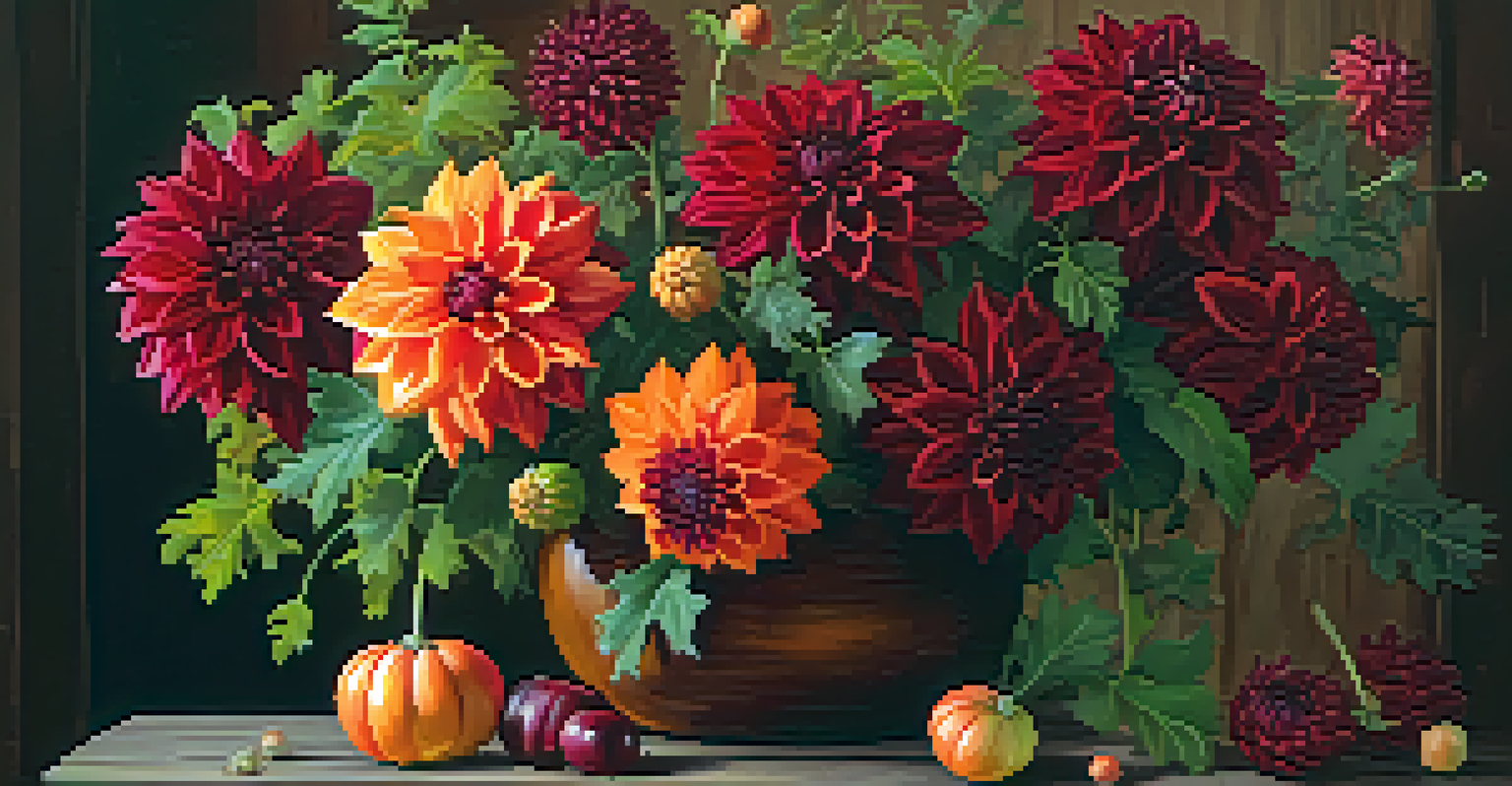Choosing the Right Flowers for Seasonal Floral Arrangements

Understanding Seasonal Flower Varieties
Seasonal flowers are available at specific times of the year, and understanding these cycles can make a huge difference in your floral arrangements. For instance, tulips and daffodils bloom in spring, while sunflowers and dahlias shine in summer. By choosing flowers that are in season, you not only ensure freshness but also vibrant colors and better prices.
Flowers are the music of the ground. From earth's lips, they speak.
Think of seasonal flowers like the local produce at a farmer's market. Just as tomatoes taste better in summer, flowers that are in season offer superior beauty and longevity. They thrive in their natural environment, which means they will last longer in your arrangements.
Additionally, seasonal choices help you create arrangements that reflect the mood and colors of the time of year. Spring flowers can evoke a sense of renewal, while autumn blooms often bring warmth and richness to your displays.
Considering Color Palettes for Each Season
Color plays a crucial role in floral arrangements, and each season has its own palette that can influence your choices. For example, spring often features pastels like soft pinks and yellows, while autumn showcases warm hues like deep reds and oranges. By aligning your flower colors with the season, your arrangements will have a natural flow.

Picture a summer garden bursting with vibrant colors—bright reds, yellows, and purples. These bold shades can invigorate your arrangements, making them perfect for outdoor events or celebrations. In contrast, winter arrangements may benefit from more muted tones and textures, creating a cozy atmosphere.
Choose Seasonal Flowers for Freshness
Selecting flowers that are in season ensures vibrant colors, better prices, and longer-lasting arrangements.
By understanding seasonal color palettes, you can evoke specific emotions and themes in your arrangements, making them more impactful for any occasion.
Matching Flowers to Seasonal Events
Certain flowers are synonymous with specific events throughout the year, and matching your selections to these occasions can enhance their significance. For instance, roses are popular for Valentine's Day, while poinsettias are a staple during Christmas. By choosing flowers that resonate with seasonal traditions, your arrangements can carry deeper meaning.
The earth laughs in flowers.
Think about how flowers can represent love, celebration, or remembrance. When selecting blooms for events like weddings or anniversaries, consider seasonal flowers that align with the event's theme. This thoughtful touch can elevate your arrangements to reflect the occasion perfectly.
Moreover, incorporating seasonal flowers can also show your guests that you're mindful of the time of year, making your arrangements feel relevant and intentional.
Prioritizing Local Flower Availability
In addition to choosing seasonal flowers, considering local availability can significantly enhance your arrangements. Locally sourced flowers not only support your community but also reduce the carbon footprint associated with transporting blooms from afar. This practice often results in fresher flowers that have a longer lifespan.
Imagine walking through a local flower shop filled with blooms grown just a few miles away. The vibrant colors and scents can inspire your arrangements, offering a unique touch that imported flowers may lack. Local flowers often reflect the specific climate and ecosystem, adding authenticity to your designs.
Align Colors with Seasonal Themes
Using color palettes that reflect each season can enhance the emotional impact of your floral displays.
Additionally, many local florists can provide expert advice on which flowers are currently in season and available, helping you make informed choices for your arrangements.
Understanding Flower Longevity and Care
Not all flowers have the same lifespan, and understanding this can help you choose blooms that will last longer in your arrangements. For instance, chrysanthemums and lilies can often outlast more delicate flowers like peonies and tulips. By mixing longer-lasting flowers with more ephemeral varieties, you can create beautiful arrangements that stay fresh longer.
Think of it like a balanced diet—combining different types of flowers can create a visually appealing and resilient arrangement. Not only does this approach enhance the beauty of your floral displays, but it also reduces the frequency of replacements needed.
Proper care also plays a role in flower longevity. By ensuring your arrangements are kept in water and away from direct sunlight, you can extend their life, making your choices even more worthwhile.
Incorporating Foliage and Fillers for Texture
When creating seasonal floral arrangements, don’t forget about the importance of foliage and fillers. Greens like eucalyptus or ferns can add depth and texture to your displays, making the flowers stand out even more. These elements are essential for creating balance and enhancing the overall aesthetic of your arrangements.
Think of foliage as the supporting cast in a movie—the flowers are the stars, but the greens help create context and enhance their beauty. Mixing various textures can make your arrangements visually interesting and dynamic.
Support Local Florists for Quality
Opting for locally sourced flowers not only supports your community but also guarantees fresher blooms with a lower carbon footprint.
Additionally, using seasonal fillers, such as berries in the fall or delicate grasses in the summer, can add a unique touch that enhances the seasonal feel of your arrangements.
Experimenting with Unique Flower Combinations
One of the most exciting aspects of creating floral arrangements is experimenting with unique combinations of flowers. Seasonal blooms can be mixed in unexpected ways to create striking contrasts or harmonious blends. For example, pairing bright dahlias with soft lavender can create a beautiful balance of color and texture.
Imagine a canvas where you can blend different colors, shapes, and sizes of flowers to create your masterpiece. Don’t be afraid to play with scale, like combining large sunflowers with delicate baby’s breath for a dramatic effect.

This experimentation not only reflects your personal style but can also lead to discovering new favorites. You might find that an unexpected combination resonates with you or your audience, making your arrangements even more memorable.